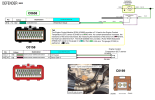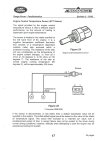I know there’s loads of threads posted about faulty temperature gauges, well now it’s my turn. I’ve read all the other ones and I’m not finding many that seem similar to my problem and they don’t really have conclusions.
My gauge sits at the bottom end and only moves up slightly after driving for a while. But when I pull up and put the clutch pedal down the needle suddenly jumps up. I got connected to the ECU and it seems to have the temperature correct, though I’ve not had a chance to see what it’s like when it gets up to temp. But it started at the ambient temp and started increasing slowly with the engine running, and was unaffected by putting the clutch down. I’ve had it all disconnected and been doing continuity tests between the cables and the body but everything seems to look good. No routes to ground once the cables are disconnected at each end. I thought it might be a grounding issue but I’ve got no other problems. The other dials share the same ground and they’re all fine.
Im thinking about hooking the ECU pin to the ground and seeing what the multimeter says but I’m not sure what I’m looking for. I’ve even had the ECU open expecting flit find loads of oil but it was absolutely clean in there. Can anyone help me out? I don’t want to change the gauge because they’re so expensive.
My gauge sits at the bottom end and only moves up slightly after driving for a while. But when I pull up and put the clutch pedal down the needle suddenly jumps up. I got connected to the ECU and it seems to have the temperature correct, though I’ve not had a chance to see what it’s like when it gets up to temp. But it started at the ambient temp and started increasing slowly with the engine running, and was unaffected by putting the clutch down. I’ve had it all disconnected and been doing continuity tests between the cables and the body but everything seems to look good. No routes to ground once the cables are disconnected at each end. I thought it might be a grounding issue but I’ve got no other problems. The other dials share the same ground and they’re all fine.
Im thinking about hooking the ECU pin to the ground and seeing what the multimeter says but I’m not sure what I’m looking for. I’ve even had the ECU open expecting flit find loads of oil but it was absolutely clean in there. Can anyone help me out? I don’t want to change the gauge because they’re so expensive.



